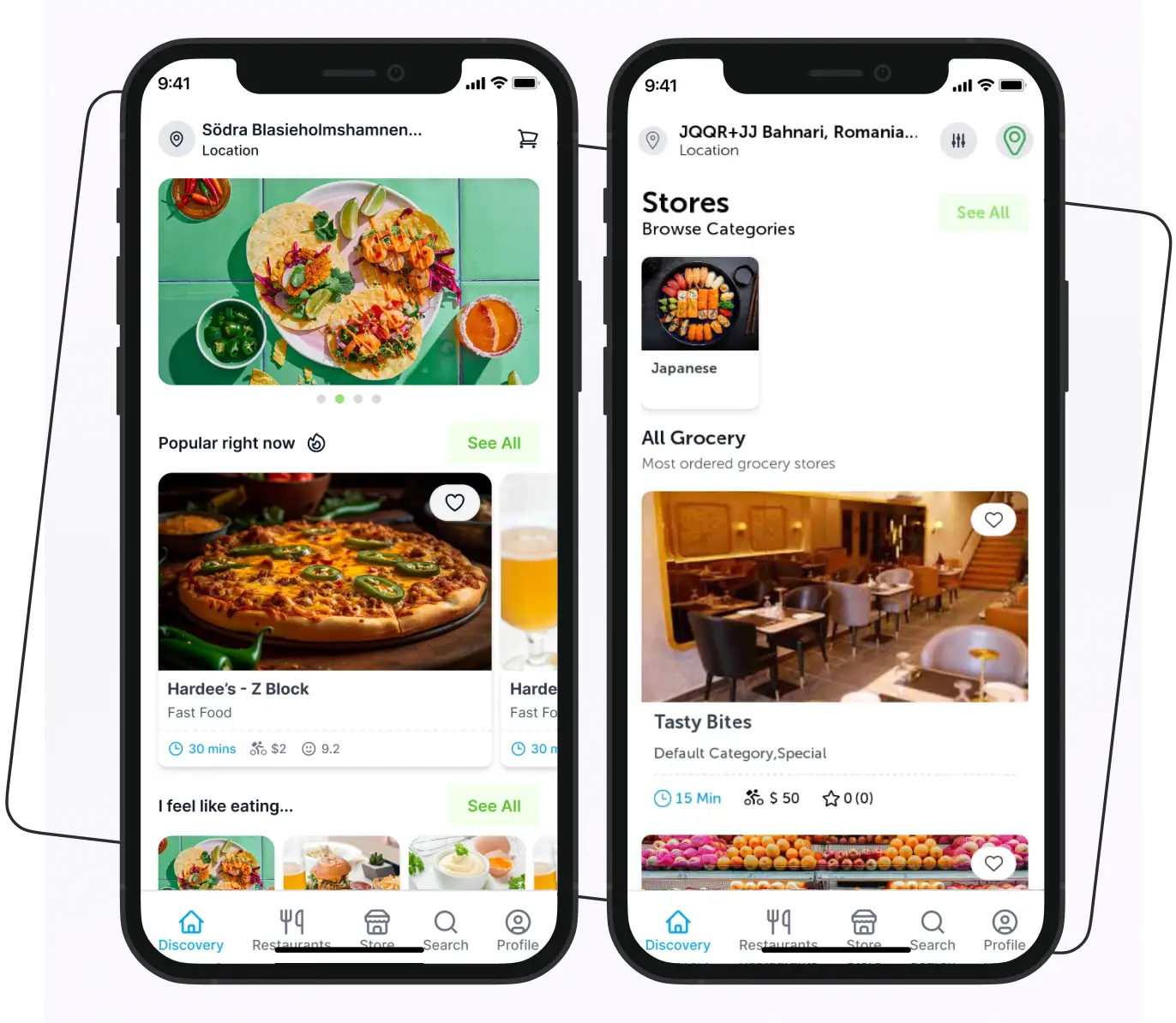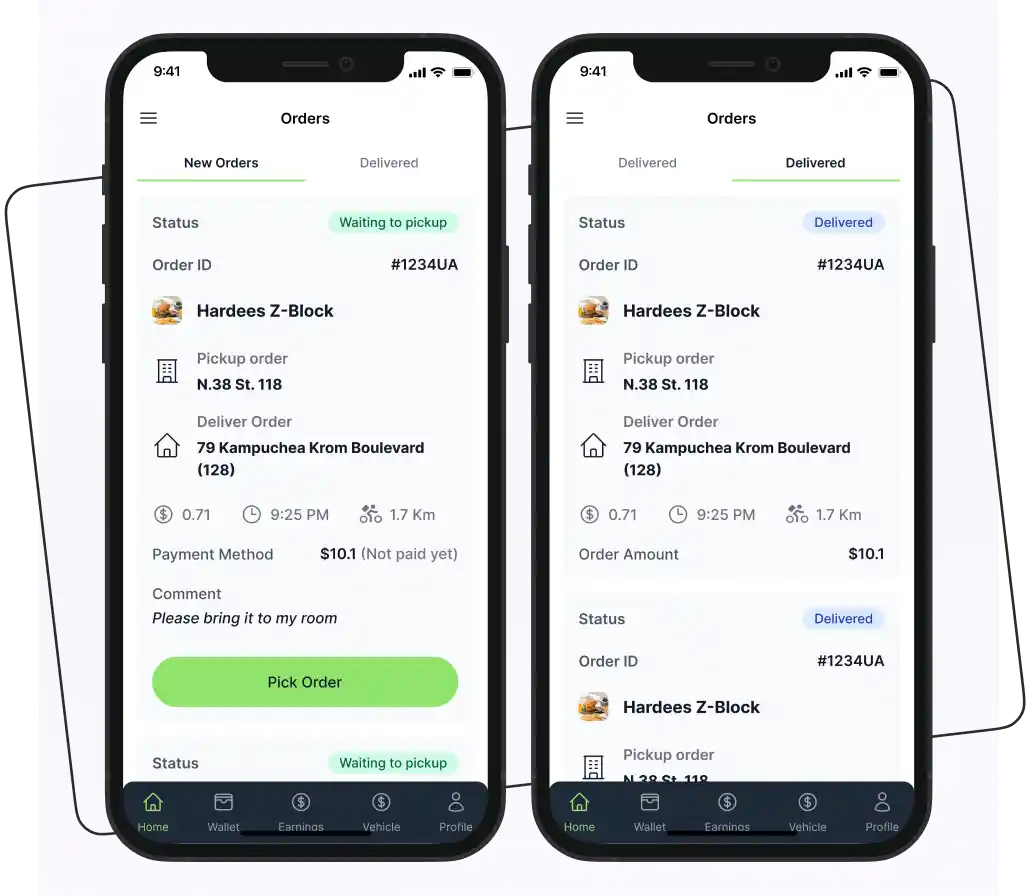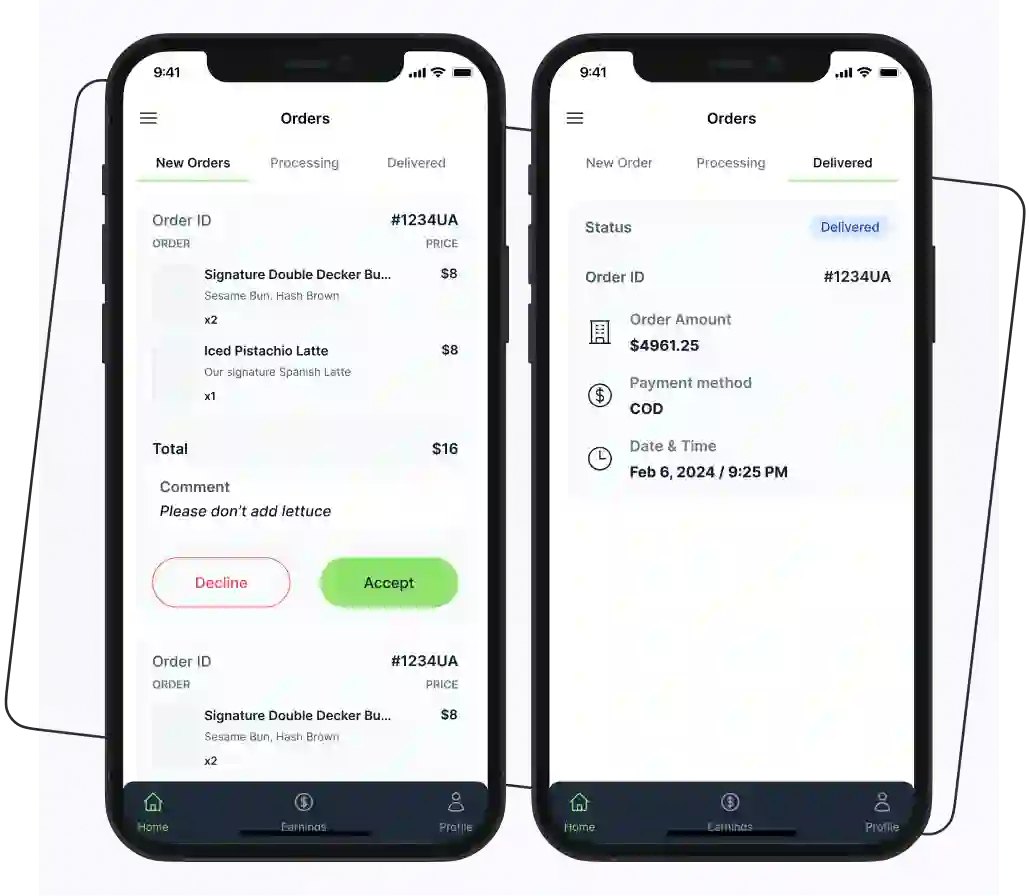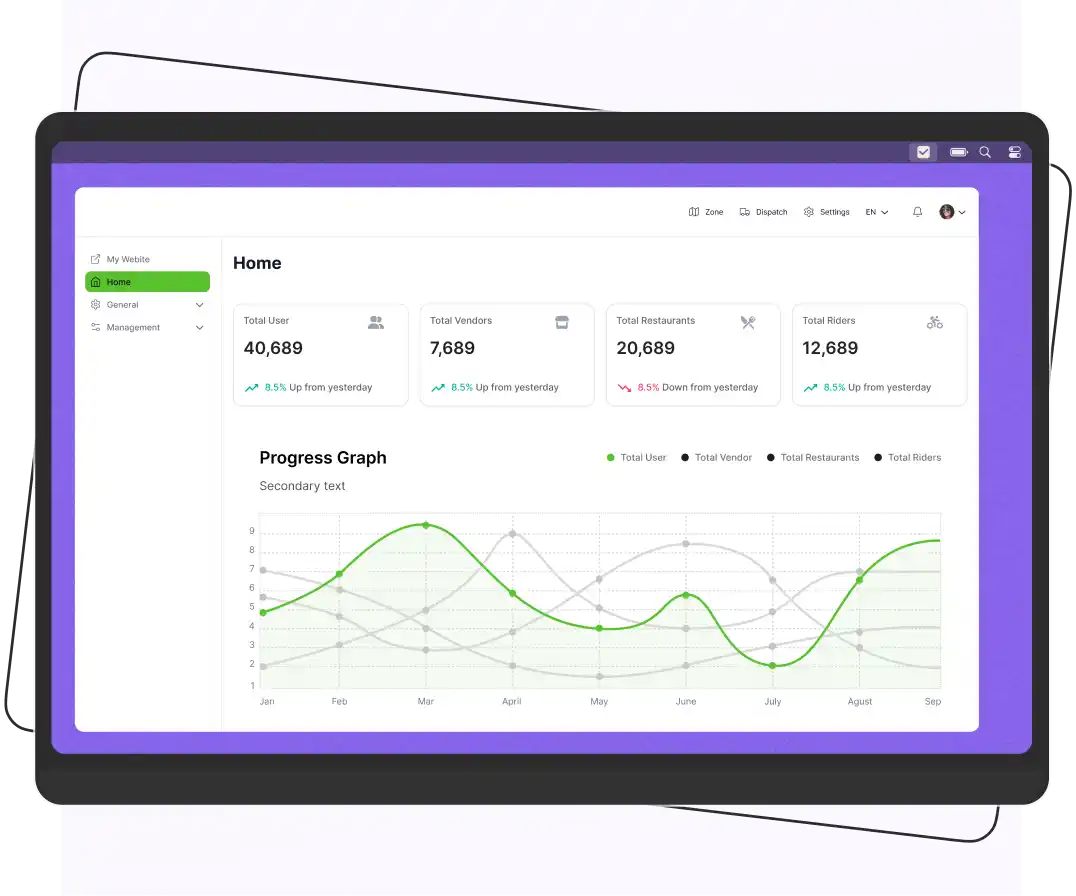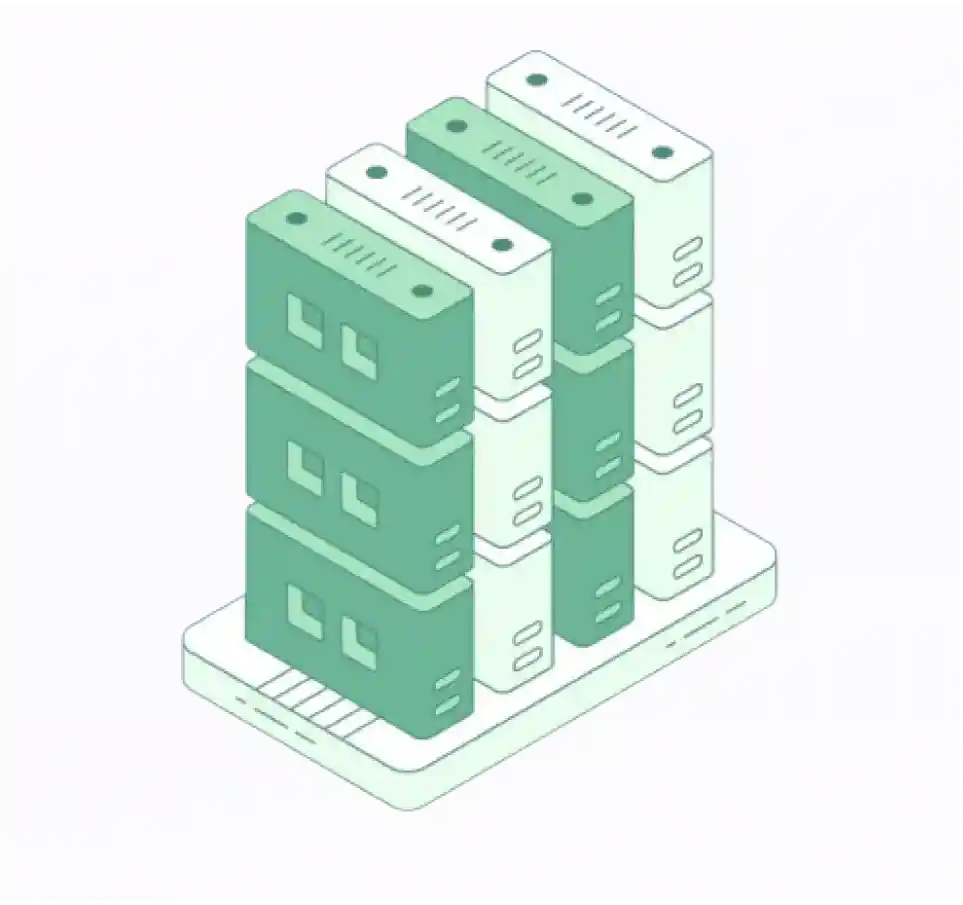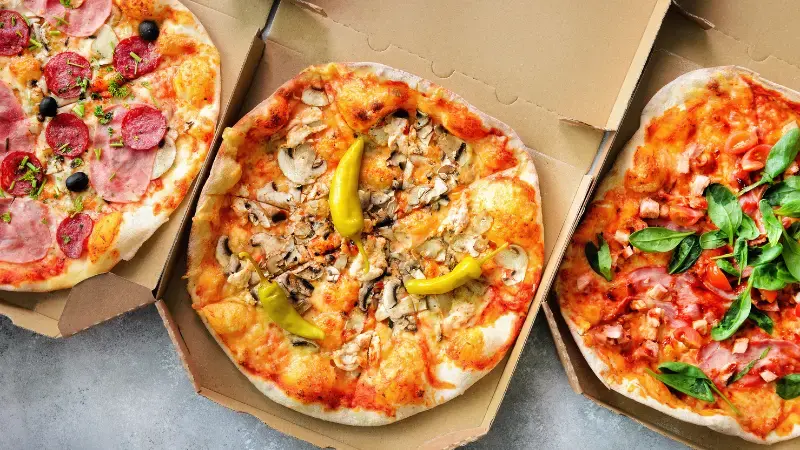
Key Takeaways
- The pizza delivery market is projected to grow to $192.4 billion by 2028.
- A pizza delivery business offers low overhead, high sales potential, and customer reach.
- Choose the right model: storefront, food truck, ghost kitchen, or franchise.
- Success depends on effective planning, solid marketing, and excellent service.
Attention business owners! If you’ve ever dreamt of owning a pizza business that gives you more revenue, start turning your dream into reality.
Starting a pizza delivery business in 2025 can lead to impressive profits. With a projected $192.4 billion market by 2028, now is the perfect time to launch your pizza delivery service.
Pizza is a comfort food that many people enjoy. It’s the go-to choice for celebrations like birthdays and anniversaries. From busy professionals looking for a quick meal to families craving a comforting dinner, the demand for pizza remains consistently high.
If you’re thinking about starting a food business, launching a pizza delivery service could be a fantastic opportunity. It offers the potential for a successful pizzeria business and earnings.
However, you might still have questions such as:
- How do I get started?
- What are the benefits of a pizza business?
- What budget do I need to consider?
In this blog, we’ll address all your questions and guide you through the process.
So, let’s explore!
Why Pizza Delivery Business?
Is a pizza delivery business profitable?
Pizza isn’t just food; it’s an experience that brings people together. From family gatherings to late-night study sessions, it’s a staple that appeals to all ages. The versatility of pizza, from classic Margherita to gourmet toppings, means there’s something for everyone, making it a prime choice for a food venture.
Investing in the pizza business opens new opportunities and provides several benefits, such as:
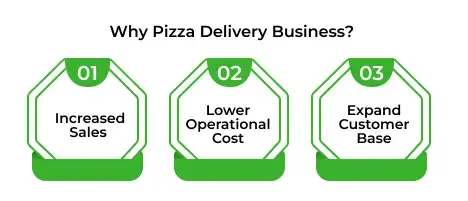
Increased Sales
Nowadays, people are busy and they don’t have time to physically visit the place to get their orders or dine in. Each person wants to save time and expects everything at their fingertips.
So, by providing the pizza delivery service, you can get more revenue and sales. Also, you can expand your reach by providing delivery services to remote areas.
Moreover, there is potential for partnerships with local businesses, which can increase visibility and attract new customers. Collaborating with schools, offices, or community events can create mutually beneficial relationships that drive sales.
Lower Operational Cost
Operational costs can also be lower compared to full-service restaurants. Pizza delivery businesses require less overhead, especially if they focus primarily on delivery rather than dine-in services. This cost-effectiveness makes it an attractive option for investors looking for a profitable venture.
Expand Customer Base
60% of U.S. consumers use online platforms for pizza or food ordering once a week. Starting the pizza delivery service gives you a competitive advantage in the pizza delivery market.
From families and college students to busy professionals, pizza attracts a wide range of demographics, allowing businesses to reach a broad audience. This diversity not only helps in generating revenue but also in building a loyal customer community.
Supercharge your deliveries with Enatega.
Launch NowPizza Delivery Business Model
Starting a pizza delivery service requires careful planning and execution. You’ll need to choose a business model. You will have to decide to operate from a storefront, a food truck, or even a ghost kitchen.
Here is a pizza delivery business model to give you a better idea.
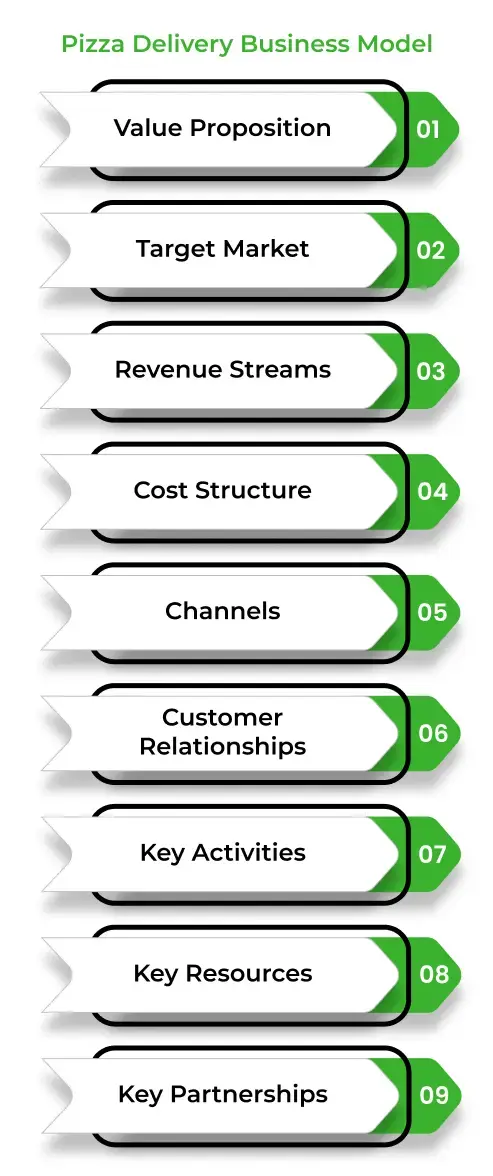
Value Proposition
The value proposition of a pizza business centers around offering high-quality products made with fresh ingredients. By providing customers with the ability to customize their pizzas by choosing from various crusts, toppings, and sauces, the business enhances the dining experience.
Target Market
Identifying the target market is essential for tailoring marketing efforts and menu offerings. The primary demographic includes families, young adults, college students, and office workers who look for convenient dining options.
The geographic focus should be on urban and suburban areas where there is a high demand for delivery services, as these locations have a larger customer base looking for quick meal solutions.
Revenue Streams
The revenue streams for a pizza business primarily come from direct sales of pizzas, which can be offered whole or by the slice, and through combo deals that encourage more significant purchases.
Moreover, revenue can be generated from selling complementary items like sides (wings, salads, and desserts) and drinks. Introducing a subscription service for regular customers, such as monthly pizza deals, can also provide a steady income stream.
Cost Structure
Understanding the cost structure is vital for maintaining profitability. Fixed costs include expenses such as rent, utilities, salaries, and equipment, which remain constant regardless of sales volume.
Variable costs, on the other hand, fluctuate with sales and include ingredients, packaging, delivery expenses, and marketing efforts. A careful balance between these costs will help ensure financial sustainability.
Channels
Effective distribution channels are important for reaching customers. An intuitive online ordering platform, including a user-friendly website and a mobile app, can improve the ordering experience.
Partnering with third-party delivery services like UberEats, DoorDash, or Grubhub can expand market reach and provide additional convenience. Maintaining a physical storefront allows for pick-up orders and catering to customers who prefer to collect their food.
Customer Relationships
Building strong customer relationships is vital for repeat business. Implementing loyalty programs can reward frequent customers and encourage them to return. Excellent customer support, available through phone, chat, or email, ensures that any issues are promptly addressed.
Engaging customers on social media platforms like Instagram and Facebook not only promotes products but also builds a strong connection.
Key Activities
Key activities that drive the business include efficient order management to handle requests from various channels. Maintaining high standards in food preparation and hygiene is essential for quality assurance.
Key Resources
The success of a pizza business relies heavily on key resources. Reliable suppliers for fresh produce and quality toppings are critical to maintaining product quality.
Well-trained staff, including chefs, delivery drivers, and customer service representatives, are essential for delivering an excellent customer experience.
Key Partnerships
Strategic partnerships improve business operations and market reach. Collaborating with local suppliers can ensure a steady flow of fresh ingredients. Partnering with delivery services extends the business’s reach and can attract new customers.
7 Steps on How to Start a Pizza Delivery Business
Below are some steps to help you start a pizza delivery startup.

1. Start Planning
To start a pizza delivery business, you will have to create a detailed business plan. Creating the business plan will work as a primary tool to represent your business structure.
In the business plan, you have to outline your business vision, operating strategies, market analysis, financial structure, and other main things that impact your business.
2. Know your Customers
In this step, conduct research and understand your target customers’ preferences. Identify your target market, whether they are students, parents with children, or time-pressed business people. With this information, you can focus on your goals and offer them what they want.
3. Select the Business Model
Now, you have to select the business model for starting the pizza delivery business, focusing on options like a traditional storefront, a ghost kitchen with delivery-only service, or a franchise model to use established branding and operational support. Each model has its pros and cons, so carefully examine them and then choose the best one.
4. Decide What to Offer
To run a successful pizza business, you are required to consider what kinds of pizzas and additional items you intend to sell. However, considering the preferences of your target market, you can create a compelling offering that attracts customers and keeps them coming back.
5. Set the Budget
It is essential to create a solid financial plan for your pizza delivery business. From the start, you have to set the budget for these things:
Food Materials
- Ingredients: Calculate the cost of high-quality ingredients such as flour, cheese, sauce, toppings, and packaging materials. Consider seasonal price fluctuations and supplier contracts for bulk purchasing.
Space
- Buy or Lease: Decide whether to buy or lease a location for your pizza delivery operations. Consider factors like location, size, and the potential for foot traffic. Calculate the initial costs, ongoing rent or mortgage payments, and utilities.
Equipment
- Pizza Ovens and Tools: Budget for essential equipment such as ovens, refrigeration units, mixers, and pizza cutters. Research both new and used options to find the best deals.
Staffing
- Labor Costs: Estimate wages for chefs, riders, and administrative staff.
Marketing
- Promotion and Advertising: Allocate funds for marketing efforts, including online advertising, social media campaigns, and local promotions. Consider creating a website and using food delivery apps.
Licensing and Permits
- Regulatory Costs: Research the necessary licenses and permits required to operate legally in your area. Budget for application fees and potential legal consultations.
Technology
- Point of Sale Systems: Invest in a reliable POS system for order management and payment processing. Consider software for inventory management and customer relationship management.
6. Delivery Logistics
Create efficient delivery routes to minimize delivery time and costs. Implement the tracking system to ensure the timely delivery of orders without any mistakes. Also, consider multiple delivery options for better management.
7. Implement Marketing Strategies
Use various marketing techniques to attract customers, such as discounts for first-time orders, referral programs, and partnerships with local businesses. With strong marketing efforts, you can improve your online presence.
Latest Trends in the Pizza Industry
In 2025, the pizza industry is changing a lot due to new technology, different customer tastes, and smart partnerships. Here are some key trends making an impact.
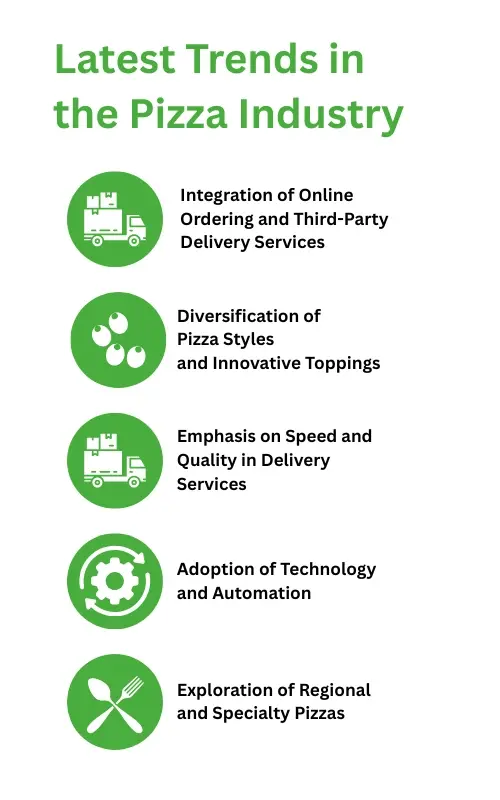
Integration of Online Ordering and Third-Party Delivery Services
A growing number of pizzerias are integrating online ordering systems and collaborating with third-party delivery platforms to enhance customer convenience and expand their reach. For instance, Domino’s has partnered with DoorDash to offer delivery services through the DoorDash app, aiming to attract new customers, especially in rural and suburban areas.
Diversification of Pizza Styles and Innovative Toppings
Consumers are showing increased interest in diverse pizza styles and unique toppings. Detroit-style pizza, known for its thick, crispy crust and caramelized edges, is gaining popularity. Additionally, spicy toppings like garlic-infused chili crisp and Calabrian peppers are trending, catering to the tastes of younger demographics.
Emphasis on Speed and Quality in Delivery Services
Timely delivery remains a critical factor in customer satisfaction. Studies indicate that carryout orders often outperform delivery in speed of service. Pizzerias are focusing on optimizing delivery logistics to ensure fast and fresh arrivals, which is essential for retaining customers.
Adoption of Technology and Automation
To manage operations and enhance customer experiences, pizzerias are adopting technologies such as artificial intelligence (AI) for order management and personalized recommendations. Automation in food preparation and delivery processes is also on the rise, aiming to improve efficiency and reduce labor costs.
Exploration of Regional and Specialty Pizzas
There is a growing interest in regional pizza varieties and specialty offerings. Pizzas inspired by Detroit, New York’s Grandma-style, and the Midwest’s Tavern-style are gaining traction. This trend reflects consumers’ desire for diverse flavors and authentic culinary experiences.
How Much Does it Cost to Start a Pizza Delivery Business?
Starting a pizza delivery business can vary widely in cost depending on several factors. Here are some key expenses to consider.
| Expense Category | Estimated Cost |
| Business Setup Costs | |
| Legal Fees | $300 – $1,500 |
| Insurance | $500 – $2,000 annually |
| Equipment and Supplies | |
| Ovens and Kitchen Equipment | $20,000 – $100,000 |
| Delivery Vehicles | $5,000 – $30,000 each |
| Packaging Materials | $500 – $2,000 |
| Location Costs | |
| Lease/Rent | $1,000 – $5,000 monthly |
| Renovations | $5,000 – $20,000 |
| Staffing | |
| Salaries | $2,000 – $5,000 per employee monthly |
| Training Costs | $500 – $2,000 |
| Marketing and Advertising | |
| Initial Marketing | $500 – $5,000 |
| Operating Costs | |
| Utilities | $300 – $1,000 monthly |
| Ingredients | $1,000 – $3,000 monthly |
| Total Estimated Costs | |
| Low-end | $30,000 – $50,000 |
| High-end | $100,000+ |
Challenges Faced When Starting a Pizza Delivery Business
Here is a list of a few challenges that business owners face when starting a pizza delivery business.
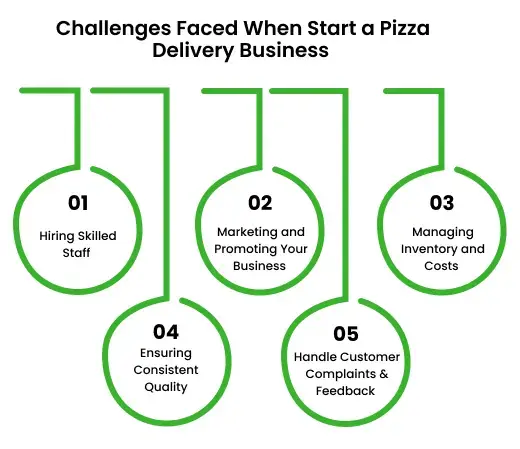
Hiring Skilled Staff
One of the biggest challenges that business owners face is hiring skilled staff. The success of your business relies on the employees’ expertise and dedication.
Solution: To overcome this challenge, you must follow a well-designed hiring process. From the start, clearly define the roles and responsibilities for each position in your business.
Creates a positive work environment, listens to their feedback, and addresses any concerns employees may have.
By investing in your employees, you will build a strong and dedicated team that will contribute to the success of your pizza business.
Marketing and Promoting Your Business
Effective marketing is essential for building brand awareness and attracting customers. Without it, you cannot build a brand image or establish a strong presence in the market. A well-executed marketing strategy helps you connect with your target audience and differentiate your brand from competitors.
Solution: Create a strong and consistent brand identity that represents your restaurant’s unique selling proposition. Use social media platforms to increase your reach and engagement. Also, invest in online advertising and partner with food influencers and bloggers to expand your reach.
Managing Inventory and Costs
Another challenge in the pizza industry is managing inventory and costs. To run a profitable business, you need to keep a balance between quality and cost.
Solution: To address this concern, regularly monitor your stock levels and track your sales to avoid overstocking. Use the latest technologies to automate your inventory tracking.
Furthermore, build strong relationships with your suppliers to help you secure better deals and discounts.
Ensuring Consistent Quality
Ensuring consistent quality and flavor is key to the success of your pizza delivery business. Customers want their favorite pizza to taste the same every time, making it essential to manage this consistency effectively.
Solution: To solve this problem, follow these tips:
- Use high-quality and fresh ingredients for making pizzas.
- Build relationships with local suppliers who can provide you with the freshest ingredients.
- Train your staff to follow the same recipes and cooking techniques.
- Conduct regular tests to ensure that your pizzas meet your quality standards.
Handle Customer Complaints and Negative Feedback
No matter how effectively you manage your pizza restaurant, there will always be times when you face customer complaints or negative reviews. It’s important to address these situations with professionalism.
Solution: Here are some strategies that you have to follow to solve this issue.
- Always listen to your customers and address their issues.
- Make improvements to prevent similar issues in the future.
- Take negative feedback positively and work on it.
Factors to Consider Before Starting a Pizza Business
Below are some factors to consider before starting a pizza business.

Market Research
Conduct thorough market research to identify your target audience, such as families, students, or professionals. Analyze competitors by visiting their establishments, reviewing their menus, and understanding their pricing strategies. This information will help you identify opportunities and differentiate your business.
Business Model
Evaluate different business models, such as dine-in, takeout, or delivery. Consider whether to start as a franchise, which offers brand recognition and support, or as an independent venture, allowing for more creativity and flexibility. Each model has its advantages and challenges, so choose one that aligns with your vision.
Location
Selecting the right location is important for attracting customers. Look for areas with high foot traffic, such as near schools, offices, or shopping centers. Assess the demographics of the neighborhood to ensure they align with your target market. A good location can impact your business’s visibility and accessibility.
Menu Development
Create a menu that includes a variety of pizzas, from traditional to specialty, and dietary options like gluten-free and vegan. This variety caters to different customer preferences and dietary needs. Set competitive prices by analyzing local competitors and considering your ingredient costs to ensure profitability while attracting customers.
Suppliers
Establish relationships with reliable suppliers who can provide high-quality ingredients consistently. This includes essential items like flour, cheese, meats, and fresh vegetables. Quality ingredients contribute to the overall taste and reputation of your pizzas, making it vital to choose suppliers who share your commitment to quality.
Licensing and Permits
Research the necessary licenses and permits required to operate a food business in your area. This may include health permits, food handler permits, and business licenses. Compliance with local health regulations is essential for ensuring safety and building trust with customers.
Marketing Strategy
Develop a pizza delivery marketing strategy to build brand awareness and attract customers. Create a strong brand identity, including a memorable logo and engaging messaging.
Finances
Calculate startup costs, including equipment, rent, inventory, and marketing expenses. Create a detailed business plan that outlines your financial projections and funding needs. Explore various funding options, such as small business loans, investors, or personal savings, to secure the necessary capital to launch your business.
Staffing
Recruit skilled staff for various roles, including chefs, servers, and delivery personnel. Focus on hiring individuals who align with your company culture and share a passion for food and service. Implement training programs to ensure that staff members maintain high standards in food preparation and customer service.
Case Study
Fireaway Pizza: From Single Store to International Franchise
Mario Aleppo founded Fireaway Pizza in 2016, investing £60,000 to open the first store in London. Using his grandmother’s Italian recipes and importing ingredients directly from Italy, he emphasized authentic flavors.
The initial success led to franchising, and by 2025, Fireaway expanded to 160 locations, including international outlets. This growth was achieved by maintaining quality and a simple menu, demonstrating the potential of combining traditional recipes with strategic expansion.
FAQs
1. Is owning a pizza business profitable?
Yes, owning a pizza business can be profitable, especially in high-demand areas. However, success depends on factors like location, quality, and effective management. Proper cost control and marketing strategies are also important.
2. How do I make my pizza business successful?
Below are some strategies to help you make your pizza business successful.
- Create a standout menu.
- Build a loyalty program to reward customers.
- Use high-quality and fresh ingredients that make your pizzas special among customers.
- Provide excellent customer service.
- Understand the requirements to start a pizza delivery business.
- Create the pizza delivery business plan and follow it.
3. What equipment do you need for a pizza delivery startup?
For a pizza delivery startup, you’ll need these types of equipment:
- A reliable vehicle for deliveries
- Insulated bags to keep pizzas warm
- A point-of-sale system for orders
- Pizza-making equipment like ovens and prep stations
4. What is the 30-minute pizza delivery rule?
The 30-minute pizza delivery rule is a marketing promise made by some pizza companies to deliver pizzas within 30 minutes of order placement. If not delivered on time, customers might receive a discount or free pizza.
5. Do you need a commercial license to deliver pizza?
No, a commercial driver’s license (CDL) is not required for pizza delivery since it involves using a standard vehicle. However, you will need a valid driver’s license and a clean driving record.
6. What is the most profitable food business?
The most profitable food businesses include food trucks, cloud kitchens, coffee shops, bakery businesses, and meal prep services due to their low overhead costs and high demand. Niches like healthy snacks, gourmet burgers, and ethnic cuisine also generate high profits.
7. How to start a pizzeria with no money?
You can start a pizzeria with no money by following these tips:
- Partnering with investors.
- Opting for a franchise with financing options.
- Launching a low-cost ghost kitchen from home using delivery platforms before scaling up.
8. What is the most successful pizza business?
The most successful pizza business globally is Domino’s Pizza. It leads the industry with the highest sales, innovative delivery technology, and a strong international franchise network.
Supercharge your deliveries with Enatega.
Launch NowConclusion
Several food trends may come and go, but pizza remains a steadfast favorite. Therefore, starting the pizza delivery business is the smart move. With passion and the right strategy, your pizza delivery business can grow.
If you're looking to develop an app for your pizza delivery service, consider consulting with
Enatega. Our team of experts can create a customized app tailored to your specific needs, setting you up for success.
Book a free demo with us today to discuss your requirements and get the top-notch pizza ordering system!












 IOS
IOS Android
Android Web
Web